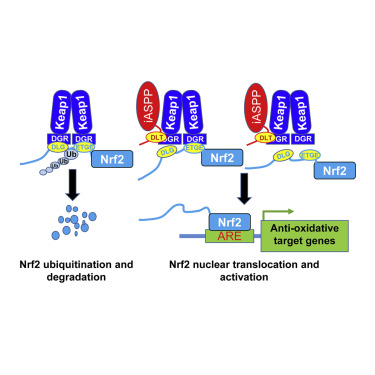当前位置:
X-MOL 学术
›
Cancer Cell
›
论文详情
Our official English website, www.x-mol.net, welcomes your feedback! (Note: you will need to create a separate account there.)
iASPP Is an Antioxidative Factor and Drives Cancer Growth and Drug Resistance by Competing with Nrf2 for Keap1 Binding.
Cancer Cell ( IF 50.3 ) Pub Date : 2017-11-13 , DOI: 10.1016/j.ccell.2017.09.008 Wenjie Ge , Kunming Zhao , Xingwen Wang , Huayi Li , Miao Yu , Mengmeng He , Xuting Xue , Yifu Zhu , Cheng Zhang , Yiwei Cheng , Shijian Jiang , Ying Hu
Cancer Cell ( IF 50.3 ) Pub Date : 2017-11-13 , DOI: 10.1016/j.ccell.2017.09.008 Wenjie Ge , Kunming Zhao , Xingwen Wang , Huayi Li , Miao Yu , Mengmeng He , Xuting Xue , Yifu Zhu , Cheng Zhang , Yiwei Cheng , Shijian Jiang , Ying Hu

|
Reactive oxygen species (ROS) have emerged as important signaling molecules that play crucial roles in carcinogenesis and cytotoxic responses. Nrf2 is the master regulator of ROS balance. Thus, uncovering mechanisms of Nrf2 regulation is important for the development of alternative treatment strategies for cancers. Here, we demonstrate that iASPP, a known p53 inhibitor, lowers ROS independently of p53. Mechanistically, iASPP competes with Nrf2 for Keap1 binding via a DLT motif, leading to decreased Nrf2 ubiquitination and increased Nrf2 accumulation, nuclear translocation, and antioxidative transactivation. This iASPP-Keap1-Nrf2 axis promotes cancer growth and drug resistance both in vitro and in vivo. Thus, iASPP is an antioxidative factor and represents a promising target to improve cancer treatment, regardless of p53 status.
中文翻译:

iASPP是一种抗氧化因子,通过与Nrf2竞争Keap1结合来驱动癌症的生长和耐药性。
活性氧(ROS)已成为重要的信号分子,在致癌和细胞毒性反应中起着至关重要的作用。Nrf2是ROS平衡的主要调节器。因此,揭露Nrf2调节的机制对于癌症的替代治疗策略的发展很重要。在这里,我们证明了iASPP(一种已知的p53抑制剂)可独立于p53降低ROS。从机理上讲,iASPP通过DLT基序与Nrf2竞争Keap1结合,从而导致Nrf2泛素化减少,Nrf2积累,核转运和抗氧化反式激活增加。这个iASPP-Keap1-Nrf2轴在体外和体内都促进癌症的生长和耐药性。因此,iASPP是一种抗氧化因子,无论p53处于何种状态,它都是改善癌症治疗的有希望的靶标。
更新日期:2017-10-12
中文翻译:

iASPP是一种抗氧化因子,通过与Nrf2竞争Keap1结合来驱动癌症的生长和耐药性。
活性氧(ROS)已成为重要的信号分子,在致癌和细胞毒性反应中起着至关重要的作用。Nrf2是ROS平衡的主要调节器。因此,揭露Nrf2调节的机制对于癌症的替代治疗策略的发展很重要。在这里,我们证明了iASPP(一种已知的p53抑制剂)可独立于p53降低ROS。从机理上讲,iASPP通过DLT基序与Nrf2竞争Keap1结合,从而导致Nrf2泛素化减少,Nrf2积累,核转运和抗氧化反式激活增加。这个iASPP-Keap1-Nrf2轴在体外和体内都促进癌症的生长和耐药性。因此,iASPP是一种抗氧化因子,无论p53处于何种状态,它都是改善癌症治疗的有希望的靶标。



























 京公网安备 11010802027423号
京公网安备 11010802027423号